Based on the existing efforts to promote sustainable aquaculture, environmental-friendly processed feeds should be addressed, developed and implemented (Frankic and Hershner, 2003). Because of the rapidly increasing of worldwide aquaculture, aqua feed's supply is less than its demand; so, many efforts are undertaken to overcome this gap. Among these efforts is evaluation of novel feed sources, such recycling some valuable agro-industrial byproducts (Hussein et al., 2001; Soltan, 2002; Hafez et al., 2003 and El-Komy, 2006) or field crops' wastes (Srour et al., 2002) and recycling some medical plants (Abd Elmonem et al., 2002; ElKomy, 2006 and Abd El-Hakim, 2008) whether to substitute one of the conventional feed stuffs in a diet or for their attractive or medical effects. Abou Khalifa (2009) mentioned that recycling waste is very important highvalue of food. Manufacturing of feed from industrial, plant waste is the key to eliminate pollution from the environment. The process of manufacturing of animal and fish feed and fertilizer from recycling waste is the most important factors for operation of unemployment reduction.
The traditional herbal remedy from Psidium guajava leaves has been medically proposed as effective treatment of acute diarrhea and dysentery. Also, guava leaf extract decreased the frequency of cough, the extract directly stimulated muscle contraction. Moreover, growth of Staphylococcus aureus and β-streptococcus group A was inhibited by extract of dry guava leaves. These results suggest that guava leaf extract is recommended as a cough remedy (Jaiarj et al., 1999).
Abdelrahim et al.(2002) found also that Psidium guajava extracts possess anti-bacterial activity. The extract of the leaves of Psidium guajava was found to inhibit edema and pain and exhibited an antipyretic effect. The extract reduced intestinal transit time and prevented diarrhea (Olajide et al., 1999). However, guava showed high content of polyphenols as natural antioxidants (Jiménez-Escrig et al., 2001). Psidium guajava, is an important food crop and medicinal plant in tropical and subtropical countries is widely used like food and in folk medicine around of the world for its chemical constituents, pharmacological, and clinical uses. A number of metabolites have been shown to possess useful biological activities belonging mainly to phenolic, flavonoid, carotenoid, terpenoid and triterpene. Extracts and metabolites of this plant, particularly those from leaves and fruits possess useful pharmacological activities. It is used also for hepatoprotection, anti-allergy, antigenotoxic, antiplasmodial, cytotoxic, antispasmodic, cardioactive, antiinflamatory and antinociceptive activities, supporting its traditional uses (Pérez Gutiérrez et al., 2008).
Camphor tree (Cinnamomum camphora or Eucalyptus camaldulensis) is traditionally used against cough, asthma and congestion. Several volatile and water-soluble toxins were found in Eucalyptustissues. Cineole and α-pinene are highly toxic terpenes. Of 10 isolated phenolic toxins, five were identified as caffeic acid, chlorogenic acid, pcoumaric acid, ferulic acid, and gallic acid. There are factors permit toxin concentrations to reach physiologically significant proportions (Anon., 1970). The present work aimed to study the effect of dietary graded levels of guava or camphor tree leaves' meals on Nile tilapia (Oreochromis niloticus) fish performance and composition.
Materials and Methods
An indoor feeding experiment was conducted to evaluate the dietary inclusion of Pasidium guajava tree leaves meal (GTLM) or camphor tree leaves meal (CTLM) concerning growth performance, carcass composition and feed utilization of Nile tilapia, Oreochromios niloticus, fry for 16 weeks.
The experimental system consisted of 15 plastic tanks (each of 16 liter water); each tank was continuously supplied with a compressed air from an electric compressor (Shenzehe Company BS410). Dechlorinated tap water was used to change one third of the water in each tank every day. Water was aerated before be used for about 24 hours to remove chlorine.
Experimental Fish: A group of Nile tilapia O. niloticus with an average initial body weight of (0.28 –0.30 g) were obtained from a private farm at AL Hamoul, Kafr El-Sheikh governorate, Egypt and transported to the wet lab. Fish were maintained in these tanks for 2 weeks before the beginning of the experiment for acclimatization purpose. The fish were fed during the acclimatization period on the basal diet (30% crude protein) at a rate of 20% of the body weight daily, at 2 times daily. The experimental treatments were tested at three tanks (replicates) for each. Fish were stoked at a density of 7 fish / tank.
Table 1: Composition (%) and Chemical Analysis (% dry matter bases) of the Experimental Diets.
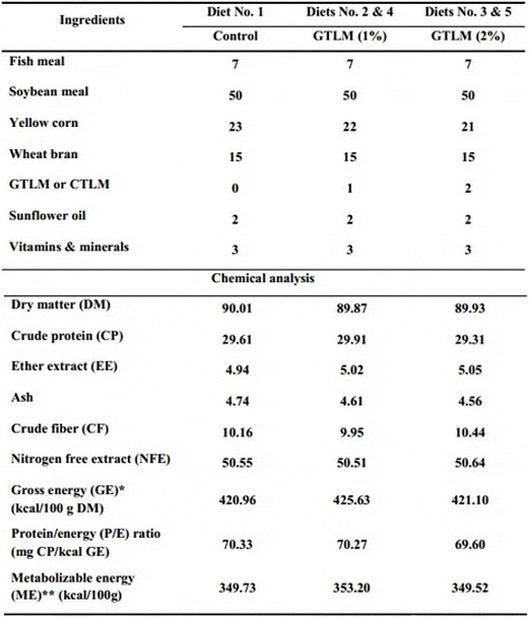
**ME (kcal/100g DM = Metabolically energy was calculated by using factors 3.49, 8.1 and 4.5 kcal/g for carbohydrates, fat and protein, respectively according to Pantha (1982).
Experimental Diet: ground dried leafs of Psidium guajava (GTLM) or camphor (CTLM) were added (0, 1 and 2%) to Nile tilapia fish diets. All feedstuffs used in the experimental diets were purchased from the local market. The basal diet No.1 was considered as a control. Composition and chemical analysis of the basal and experimental diets are presented in Table 1 which showed that all the experimental diets were iso-caloric and iso-nitrogenous. The composition of the vitamins and minerals mixture is presented in Table 2.
Table 2: Composition of the Vitamins and Minerals mixture * (calculated for each kg of the mixture) in the Diets
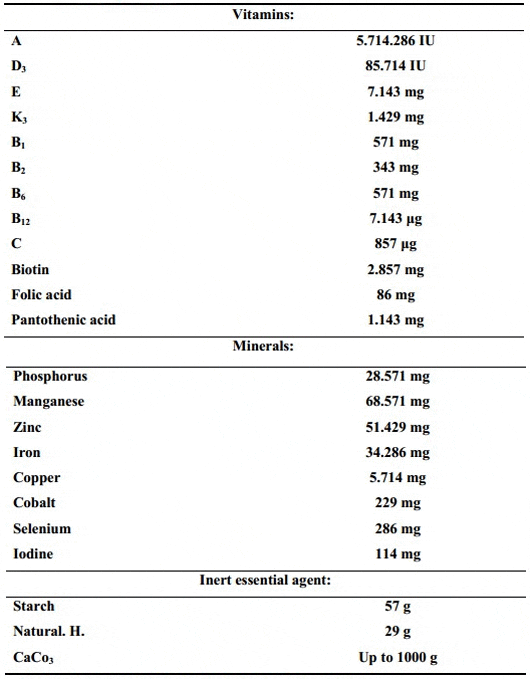
Experimental Procedure
The experiment continued for 16 weeks. During the experimental period, the fish were fed the experimental diets at a rate of 20% of the live body weight daily. The diet was introduced twice daily, at 8 a.m. and 2 p.m. The amount of feed was adjusted weekly based on the actual body weight changes. Samples of water were taken from each tank to determine water quality parameters. Light was controlled by a timer to provide a 14 h light: 10 h dark as a daily photoperiod.
Analytical Methods
Samples of water from each aquarium were taken to determine the water temperature, pH value, and dissolved oxygen concentrations according to Abdelhamid (1996). Water temperature in degree centigrade was recorded every day by using a thermometer. The pH value of water was measured daily using an electric digital pH meter (Jenway Ltd, model 350-pH meter). Dissolved oxygen concentration was determined weekly using an oxygen meter model (d-5509). Determinations of DM, CP, EE, CF,and ash in the diets and in fish body at the start and at the end of the experiment for different groups were carried out according to the methods of A.OA.C. (1990). At the end of the experiment, three fish were derived from each group (tank) for drying at 60ºC for 48 hours and then milled through electrical mill and kept at 4oC until analysis.
Growth Performance and Efficiency of Feed and Protein Utilization
The growth performance and feed utilization parameters were calculated according to the following equations:
Average weight gain (AWG, g/fish) = Average final weight (g)-Average initial weight (g).
Average daily gain (ADG, mg/fish) = [Average final weight (g)-Average initial weight (g)] 1000 / Time (days).
Survival rate (SR %) = Total number of fish at the end of the experiment×100/total number of fish at the start of the experiment.
Relative growth rate (RGR) = Average weight gain (g) / Average initial weight (g).
Specific growth rate (SGR, % / day) = 100 [ln wt1- ln wto/T].
Where: ln: Natural log. Wto: Initial weight (g), Wt1: Final weight (g), and T: Time in days.
Feed conversion ratio (FCR) = Total feed consumption (g) /Weight gain (g).
Protein efficiency ratio (PER) = Body weight gain (g)/protein intake (g).
Protein productive value (PPV %) = 100 [Retained protein (g)/protein intake (g)].
Energy retention (ER %) = 100 [Retained energy (Kcal) / Energy intake (Kcal)].
Statistical Analysis
The data were statistically analyzed using General Linear Models (GLM) procedure adapted by SAS (1996) for users guide. Means were separated using Duncan's multiple range test (Duncan, 1955).
Result and Discussion
Water Quality
Water quality parameters measured (temperature, pH and dissolved oxygen) did not differ among treatments (Table 3). Values of the measured criteria were within the normal-suitable ranges for rearing Nile tilapia fish (being 24 – 26 ºC, 7.5 – 8.5, and 5 – 6 mg/l, respectively) according to Abdelhamid (2009).
Table 3: Means of Some Water Quality Criteria in the Experimental Fish Tanks

Growth Performance
Tables 4 and 5 illustrate the means ± standard errors of the tested growth performance parameters. The dietary inclusion of guava or camphor leaves' meals (particularly at 2 % level) significantly (P≥0.05) improved each of final weight (FW), average weight gain (AWG), and average daily gain (ADG) as shown in Table 4 as well as relative growth rate (RGR) and specific growth rate (SGR) as given in Table 5 comparing with the control. Meanwhile, there were no significant (P?0.05) differences among treatments in the survival rate (SR). However, dietary inclusion of medicinal plants (garlic, El-Saidy and Gaber, 1997; onion and garlic, Zaki and El-Ebiary, 2003; Allium sativum and Thymus vulgaris, Attalla, 2009a) often increases fish performance, nutrients utilization, and chemical composition. In this respect, Arima and Danno (2002) isolated four antibacterial compounds from guava leaves which may be responsible for improving fish growth.
Similar results were obtained by El-Dakar et al. (2004a) who found that 2% dietary inclusion of dried basil leaves was palatable and improved digestibility of protein and energy, so increased weight gain, SGR, feed efficiency, and PER.
Additionally, ElDakar et al. (2004b) reported that 2% dried marjoram leaves in the diet of hybrid tilapia fingerlings significantly enhanced all fish growth performance and feed and nutrients utilization parameters. Also, Abd El-Hakim (2008) fed brood stock tilapia fish on licorice or ginger included diets that improved fry performance. Since 1 % addition level led to better final weight, gain, SGR, survival and feed conversion. Moreover, Attalla (2009b) mentioned also that feeding with a mixture of ginger (powder and oil extract) can promote all growth parameters and decrease mortality rate of Nile tilapia.
Table 4: Means* of Some Growth Performance Parameters of the Experimental Fish, during the Present Study.
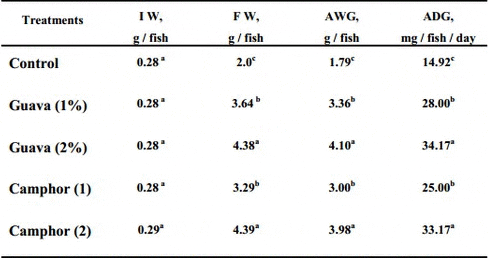
IW: initial weight, FW: final weight, AWG: average weight gain, ADG: average daily gain
Table 5: Means * of Relative Growth Rate (RGR), Specific Growth Rate (SGR) and Survival (SR) Rate of the Experimental Fish, during the Present Study.
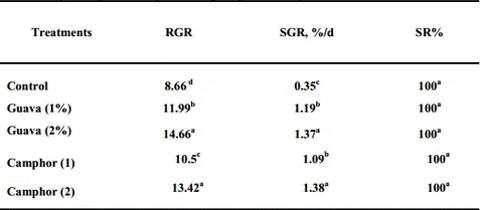
Feed Utilization
Both additives significantly (P≥0.05) improved each of feed intake, feed conversion ratio (FCR), protein intake, protein productive value (PPV), protein efficiency ratio (PER), and energy retention (ER) comparing with the control and proportional to the increase in the additive level in the diets as presented in Table 6. However, dietary inclusion of medicinal plants (garlic, El-Saidy and Gaber, 1997; onion and garlic, Zaki and El-Ebiary, 2003; Allium sativum and Thymus vulgaris, Attalla, 2009a) often increases fish performance, nutrients utilization, and chemical composition. Gaber (2000) concluded that 8 mg clove oil/100g diet significantly increased weight, length, feed efficiency, and protein and fat contents of flesh of Nile tilapia fingerlings comparing with the control. El-Dakar et al. (2004a) found that 2% dietary inclusion of dried basil leaves was palatable and improved digestibility of protein and energy, so increased weight gain, SGR, feed efficiency, and PER. El-Dakar et al. (2004a) found that 2% dietary inclusion of dried basil leaves was palatable and improved digestibility of protein and energy, so increased weight gain, SGR, feed efficiency, and PER.
Additionally, ElDakar et al. (2004b) reported that 2% dried marjoram leaves in the diet of hybrid tilapia fingerlings significantly enhanced all fish growth performance and feed and nutrients utilization parameters. Similar results were obtained when Khalafalla and Salem (2006) replaced up to 20% of yellow corn energy by olive cake without harmful effect on the tilapia growth performance and feed utilization. Also, Abd El-Hakim (2008) fed brood stock tilapia fish on licorice or ginger included diets, that improved survival rate and led to better feed utilization (to produce 1000 fry). Abdelhamid et al. (2004, 2006 and 2012) came to the conclusion that mallow, water hyacinth, and duck weed plants, respectively can be included in fish diets without harmful effects.
Moreover, Attalla (2009b) mentioned also that feeding with a mixture of ginger (powder and oil extract) can promote all growth parameters and decrease mortality rate of Nile tilapia. These positive effects of most feed additives are due to their active pharmacological (medical) substances.
Table 6: Means* of Feeed Utilization Parameters of the Experimental Fish, during the Present Study.
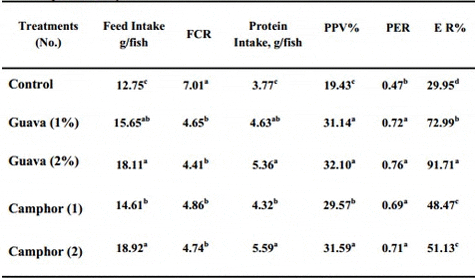
Carcass Composition
Tables 7 and 8 illustrate the data of proximate analysis of the fish before and after carrying out of the experiment, respectively. At the end of the experiment, the dry matter (DM) and crude protein (CP) percentages increased but the ether extract (EE) and / or ash contents decreased comparing with the analysis before the start of the experiment. However, the dietary inclusion of guava or camphor leaves meal significantly (P≥0.05) increased each of CP, EE and energy content (EC) of the fish body (Table 8) comparing with the control.
Yet, DM and ash contents did not reflect any significant (P≥0.05) alteration due to the dietary additive. Table 8 presents also positive relationships between both CP and EE on one side, and between CP and ash, and between EE and EC on the other side. El-Kholy (2012) fed marjoram (Marjorana hortensis) or sage (Salvia officinalis) as feed additives and found increases in weight gain, feed efficiency and protein content in whole body composition of tilapia hybrid (Oreochromis niloticus x Oreochromis aureus) monosex fingerlings at levels of 150 and 300 mg/kg diet, respectively comparing with the control. Similar to the present data, a negative relationship between crude proteins and crude fats in the chemical composition of Nile tilapia fish was reported before (El-Ebiary and Zaki, 2003 and Abdelhamid et al., 2007). Yet, El-Saidy and Gaber (1998 and 2002) and El-Saidy et al. (1999) found that there was a positive correlation between crude protein and fat contents of the fish. A positive correlation between crude protein and crude ash contents of Nile tilapia fish was reported also by Abdelhamid et al. (2000 and 2007) and El-Saidy and Gaber (2002).
Table 7: Chemical Composition (% dry matter basis) of the Experimental Fish at the Start of the Present Study.
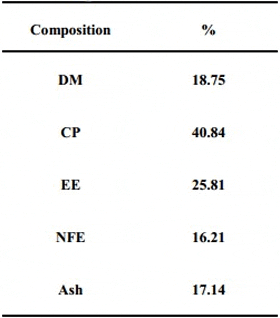
Table 8: Means* (± SE) of Chemical Composition (% dry matter bases) of Nile Tilapia Carcass as affected by the Dietary Treatments, during the Present Study..
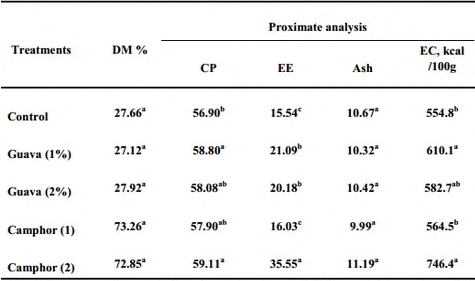
These positive effects of the used feed additives are due to their active pharmacological (medical) substances, since guava leaves are containing flavonoids (Lozoya et al., 2002). Moreover, the extract from the leaves of Psidium guajava inhibited spontaneous contractions in the unstimulated ileum with a concentration-response relationship (Lutterodt, 1989). Moreover, potassium is an essential macronutrient in higher plants. It plays an important physiological role in stoma movements, osmoregulation, enzyme activation and cell expansion. The demand for potassium can be substantial, especially when the plant concerned is a Eucalyptus tree in excess of 50 m tall.
Two cDNAs, EcHKT1 and EcHKT2, were isolated from Eucalyptus camaldulensis (Fairbairn et al., 2000). The osmosensing function may provide E. camaldulensis with a competitive advantage in maintaining K+homeostasis under certain conditions (Liu et al., 2001). Conclusively and from the results of the present study, it could be concluded that the dietary addition of 2 % either guava or camphor tree leaves meal to Nile tilapia fry (0.28 g), improved its performance.
June 2013




